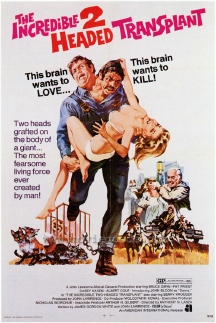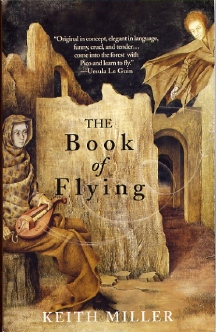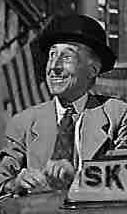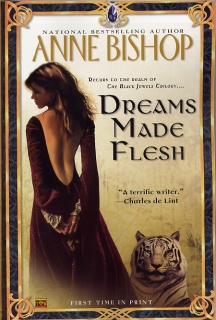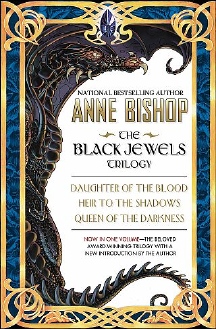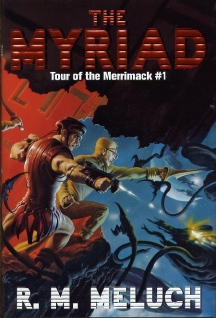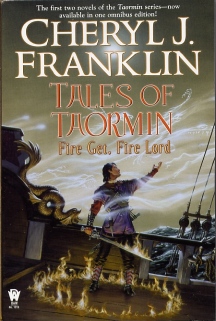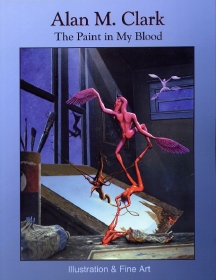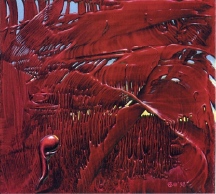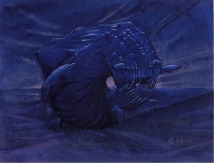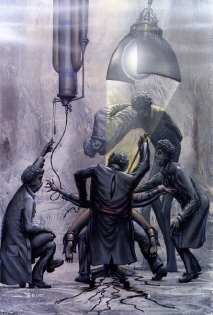|
|
|
This Just In...News from the Agony Column
|
12-31-04: 'The Book of Flying' by Keith Miller |
||||||
Fantasy
That Rated Publication as Literature
Vladimir Nabokov was never shelved next to Larry Niven. Elements of the fantastic are present in the earliest forms of literature and in many texts considered required reading for students of literature. Philip Roth is garnering acclaim with a bestselling alternate history. So why do genre fiction readers and literary fiction readers have to be treated as different people? It's not like we're the Incredible Two-Headed Transplant. Or if we are, that would only mean that we can read twice as many books. Presumably that should make both publishers and booksellers glad. Fantasy, science fiction, literature, it's a continuum. Yes, I know, all of these arguments are as old as the trees. What brings them up again today, on the last day of the year? Well, it's yet another book I received, this one from literary imprint Riverhead Books. 'The Book of Flying', by Keith Miller (Riverhead / Penguin Putnam ; January 4, 2005 ; $14.00), a book I -- and probably a number of other readers -- managed to miss in hardcover precisely because it was released by a literary imprint and shelved with literary -- as opposed to science -- fiction. And for my readers who enjoyed VanderMeer's and Bishop's work, this novel sounds a treat. As readers know, the only reason that booksellers are loathe to shelve books like this in two different areas of the bookstore is that mucks up their inventory procedure. But by now, most of them should be using those hand-held bar-code readers, and to my mind that gives them no excuse. Shelve the book between copies of the potboiling bestsellers if it helps sell them. Books like VanderMeer's, Bishop's and Miller's deserve a wide audience simply because they offer a vision that a lot of people will respond to -- if they ever manage to hear about the book. So 'The Book of Flying' is yet again a perfect book for Agony Column readers.
Chances are readers will have to embark upon their own journey to find 'The Book of Flying', though they aren't likely to meet monsters on their quest. More likely readers of T. C. Boyle, Jonathan Franzen and other literary luminaries. Of course, since many of my readers are probably Incredible Two Headed Transplants, they'll have an easy time looking in both the SF and the Literary fiction aisles. One lives to Read Science Fiction! One Lives to Read Literature! Both live to read! And both are willing to spend money to find good books, even if said books need to be shelved in two places at once. A story that booksellers evidently are in need of hearing. |
|
12-30-04: Dreams Made Flesh by Anne Bishop |
|||||||||
No
Undergarments Required
So it was in the grips of an unusual bookstore where Anne Bishop's work, which was already in my inbox rather leaped out at me. Or rather, the bare back of her heroine caught my eye. So score one for the cover designer. But what it made me think about was the prevalence in fantasy illustrations of clothing and garb that neither has nor allows undergarments. OK, so, there's something wrong with me. I know that, you know that now if you didn't before, and let's get past exactly what's wrong with me and back to the topic at hand. Life without undergarments. Now I'm sorry, in most of these fantasy worlds, the folks are not leading lives that you could call sedate. They running about, casting spells, getting kidnapped and held hostage, swinging swords and slinging arrows at wary and unwary foes. That's not the kind of activity that lends itself a backless dress, now is it? Moreover, there's a manufacturing question here well. Do all these fantasy realms have what, a sort of super China somewhere out there, where virtual slaves sew garments for fifteen hours day? Don't these damn heroes give a hoot about sweatshop labor? They're out there trying to free realms of -- I guess, what farmers? "Artisans"? -- and doing so on the backs of those who sew their improbable costumes. Harrumph. Well. It certainly doesn't pay to examine these things too closely, now does it? But that's what happens when you've not been in your happy home for a number of days, and your own undergarments are beginning to run low. These concerns rise to the forefront, casting a new light on the fiction you read, and whoosh in one swell foop, travel has broadened your mind. Well soon enough I'll be ensconced in a room full of books with my mind narrowing rapidly back to its previous, picket-fence mentality. And I don't even have a picket fence!
The story so far plays like this. There are three novels in the Black Jewels (sigh) Trilogy. In the first book, 'Daughter of the Blood', Jaenelle is just a young'un, but not surprisingly she's powerful as all get-out, a Witch to rule witches. Turns out these books are set in the Blood Realms, not the red states, as you might think. Witches run everything and men serve women in the ideal version of that world, but it's apparently in close proximity to Hell and this potentially benign setup has rapidly gone there. So good ol' Saetan, High Lord of Hell (I'm guessing the improbably handsome High Lord of Hell) takes Jaenelle under his metaphorical wing. Scanty outfits all around lead to romping romance, and lots of salacious but pleasantly surreal action. You've got Daemon (no, not one of your enjoyable Unix daemons, this Daemon is -- I'm guessing -- improbably handsome) who just happens to be the son 'o Saetan and a rebellious lad. Funny how that works out, innit? Somewhere in the works is Lucivar, Jaenelle's brother, and the upshot is Jaenelle lives another day to get closer to de-throning a Queen who might be described as Evil. But in Bishop's world, evil is definitely a relative term.
Phew. Damn. We've gone to hell and back, ain't we readers, and I've just got to this latest book. 'Dreams Made Flesh' offers up a short story and three novellas about the ever-delightful Blood Realm. 'The Prince of Ebon Rih' finds Lucivar loving outside of his class and getting in hot water. 'Zuulamam' finds Saetan and his pregnant wife engaging in 'Ransom of Red Chief' antics that result in a killing rage. I think O. Henry might not approve. 'Kaeleer's Heart' finds Jaenelle and her lover Daemon sending mixed romantic signals, which in the Blood Realm tends to lead to massacres and well as happy endings. Presumably, if those massacred worked in the sweatshops that made those clingy clothes, one could consider their deaths a happy ending. So, in general, one would be inclined to recommend the work of Anne Bishop -- and her website,which is very informative -- to those whose tastes trend towards the dark and unusual. But also, one must like one's darkness a bit on the light side as well. Funny how that works out. So, indeed, travel does broaden the mind. Or it makes the narrow mind such as mine completely, certifiably crazy-as-a-bedbug. Now, I've never seen a bedbug, and I don’t know how you determine the relative sanity of a bedbug. Maybe I'll learn this on another journey. But you know, that's the kind of information I prefer to find between the pages, as opposed to between strange sheets. Yep. Pa Kettle, Reader, reporting for duty. |
|
12-28-04: Cheryl J. Franklin's 'Tales of the Taormin' |
|||
'Fire
Get' and 'Fire Lord', Science Fiction and Fantasy
What, am I a movie trailer? Stop that! Time to rewind! Readers know I have a certain love of the work of Jack Vance. Now, one way to follow up in his steps is via the Matt Hughes / 'Black Brillion' tactic. I'm on vacation right now, and that book made my shortlist of what to bring. Another way to follow up in the steps of Jack Vance is demonstrated in the soon-to-be-re-issued-as-an-omnibus-volume, 'Tales of the Taormin: Fire Get, Fire Lord' by Cheryl J. Franklin. (DAW Trade Paperback ; January 30, 2005 ; $14.00). Where Hughes worked the science fiction side of the science fantasy equation, Franklin works the fantasy side of the equation. Of course, if you were to scan the cover copy and images, you might think you had just part of another GCFT (Generic Celtic Fantasy Trilogy). But there's more to Franklin than meets the eye. Perhaps even more than you'll find in this volume. From the get-go, I detect a Vance vibe in the very naming of the characters. And, indeed, the books do start out in the realms of high fantasy. In a world where...well, there are kingdoms and one that calls itself Serii, wizards once enslaved entire lands. This was not particularly welcome by those who lived in those lands, and when the power went away, it and those who wielded it were shown the door and not exactly encouraged to return at their earliest convenience. That puts lady Rhianna in a bit of a spot. She knows that she, as they say, "has got the power" and this particular power is not the power to run her dishwasher during a low-usage time period. Rather, she's touched with magic that she has to keep bottled up. Now readers can guess that this bottling-up scheme is neither enjoyable nor particularly effective in the long run. What's worse is that some guy -- it's always the guys who go bad first, innit? -- some random guy named Lord Venkarel has got the power but managed to skip the scruples. Readers can imagine that they're irresistibly drawn together, like peanut butter and jelly. It's a natural combination. Rhianna ain't no shrinking violet. She's practical and intelligent, but she's definitely on the side of good. Venkarel can go either way -- good or evil, that is -- and history -- both real and fantastic -- demonstrates that absolute power corrupts absolutely. 'Tales of Taormin' combines 'Fire Get' and 'Fire Lord' from 1987 and 1989 respectively. Based on the evidence, you’d think that all you've got here is pretty much fantasy; but that leaves out the one the got away. 'Fire Crossing', from 1991, takes things into a more science fictional realm, as a wizard is sent to spy on the technologically advanced civilization that created him and those like him. Things get crossed over here into Franklin's 'Network-Consortium' series, a much more outright Vancian combination of science and sorcery with Faerie folk having booked it to another planet and having pissed off those they left behind in the process. Now, the first book in the 'Network-Consortium' series, 'The Light in Exile' came out in 1990, shortly after the two books collected in 'Tales of the Taormin'. It was followed by 'Fire Crossing'. One wonders how DAW will handle this. Clearly, 'Fire Crossing' belongs with 'Fire Get' and 'Fire Lord'. But at 624 trade paperback pages, 'Tales' was already pretty hefty, and to my mind, just on the right side of imposing -- as in NOT. So real cliffhanger here is contained not in the novels in themselves, but in the publication thereof. Will DAW combine the two series in a set of two-fer re-issues? Will they separate the Taormin from the Network Consortium Books? Will the re-positioning from science fantasy to high fantasy sink or sell? The horrible fact is that an author's livelihood depends upon it. And to my mind, this sort of thing deserves to sell. "In a world where Michael Crichton and Dan Brown dominate the bestseller lists can one science fantasy author bring back the magic to survive?" Coming soon to a bookstore near you! |
|
12-27-04: Alan M. Clark Reveals 'The Paint in My Blood' |
|||||||||||||
Let It Bleed
Some of the most entertaining parts of Jonathan Lethem's last novel, 'The Fortress of Solitude', were those dealing with the painting and art of Abraham Edbus, the father of the main character in the novel, Dylan Edbus. Abraham is a perfect product of the 1960's. He's an experimental painter who paints images on film. The passages describing his work are intriguing and entertaining. Of course, painting on film doesn't pay the rent. For that, Abraham turns to painting covers for science fiction novels. It's work he despises, but does so well, he's eventually accorded an award in a scene that for me was one of this fantastic novel's highlights. Alan M. Clark is like the well-adjusted and successful version of Abraham Edbus. In fact, the parallels are positively eerie. But first let me get to his new book, 'The Paint in My Blood' (IFD Publishing ; November 1, 2004 ; $29.00, $49.00, $175.00). Notice the three prices? Of course you did. The first price, $29.00, gets you a beautiful trade paperback book, with heavy thick pages and a gorgeous print quality. The second price gets you a limited hardcover edition, one of 500 copies. The third price gets you a lettered edition, one of 26, in a metal tray-case, designed by Imagine Metal and utilizing Clark's artwork. The tray-case also holds a matted sketch from the production of one of the paintings in the book.
Clarke's work hangs on both side of the wall that one might erect were one inclined to separate the science fictional from the surreal. In fact, in a single painting, Clarke often manages to walk right through that wall and back again. And nowhere is this more apparent than in the CD that accompanies the regular and limited editions of the book. Again, an important side note. Clark's CD works seamlessly, assuming you have QuickTime and Acrobat, and you'd have to work hard not to have them. I have an OS X Mac, and I've popped in many a CD to have it spit out again as a PC-only production. That's absolutely not a problem here; and it also worked without a hitch on my son's HP Windoze machine as well. OK, a Sysadministrivia completed, the CD was something of a revelation in itself. For here you get the modern and rather astonishing twenty-first century version of the film painting techniques of Abraham Edbus. Open up the PDF document on the CD, and you'll see four chapters, each a different short film by Clark. The first film -- the aptly named 'Controlled Accidents' -- demonstrates Clarke's surprisingly (to me) abstract techniques. His work seems so precise, so perfectly planned that it shocked the hell out of me to see him laying down backgrounds with aluminum foil and lead pipe. It's fascinating insight into the process the artist uses and enables the reader / viewer of the book to approach the work with a very different understanding.
As with many of the books that come my way, seeing this book paved the path for the purchase of another by the author, in this case 'The Pain Doctors of Suture Central'. I remember seeing this book at Spookycon and being really intrigued. The story behind that book floated to the surface for me in this one. Apparently, Clark fell victim to a bacterial infection of the brain that resulted in hallucinations and seizures, even as he was being operated on. That would explain the surreal and quite disturbing story behind the paintings in this collection, one I'll have to find used. Well, that's what the Internet is for. And as well, it's for the publication of his interview with no less than Jeff VanderMeer over on SFSite. I'd suggest that readers give this the attention it deserves. Clark's an intense guy, and maybe a little bit scary, like his art. Well, to be honest, his art is a lot scary. In the event you're not fulfilling your quota of nightmares when you sleep, you can always pick up 'The Paint in My Blood' and enjoy Clark's nightmares when you're awake. I suspect that you'll easily meet your minimum daily nightmare nutritional requirements afterwards. Your sleep may suffer, but your days will be filled with darkness. Assuming, of course, that the apocalypse does not come to pass. |
